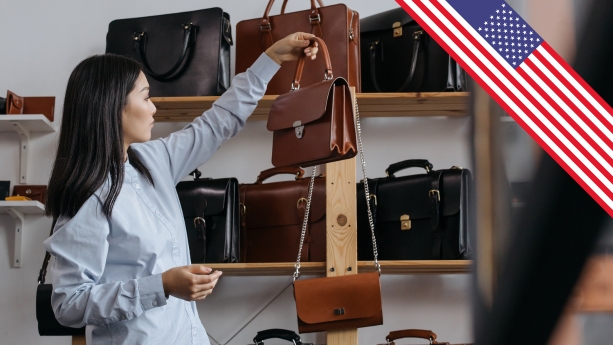
Leather products sold in the United States must comply with chemical restrictions, labeling, and other requirements. Some are specific to leather products, while others apply to coatings, heavy metals, or consumer products in general.
In this guide, we take a closer look at 16 CFR Part 24, California Proposition 65, and other requirements applicable to leather products in the United States.
Product examples
- Leather bags
- Leather belts
- Leather wallets
- Hides
- Leather furniture covers
- Other leather products
Content Overview

FREE CONSULTATION CALL (US, EU & UK)
- Request a free 30-minute call with Ivan Malloci to learn how we can help you with:
- Find product requirements
- Certification and labeling
- Lab testing
16 CFR Part 24 – Guides for Select Leather and Imitation Leather Products
16 CFR Part 24 addresses the potential misrepresentation of the composition and characteristics of leather and imitation leather products, such as instrument cases, ring binders, wallets, and footwear.
The regulation aims to protect consumers from product deception and false claims concerning product characteristics. It generally requires you to ensure that the information you provide about your product is factually correct.
Deception
In general, the regulation indicates that deception involves unfair misrepresentation of a product’s material aspect. For instance, you deceive consumers if you misrepresent the characteristics of a leather purse, such as durability, material thickness, or origin.
It is also unfair to deceive your consumers as to the composition of your leather, or simulated leather, product. Here are some examples of how you should and should not disclose the composition of your leather product:
a. You should disclose imitation leather as “Simulated leather” to prevent misrepresentation of composition.
b. You should disclose embossed leather accurately, e.g., “Top Grain Cowhide With Simulated Pigskin Grain.”
c. If the backing material of your product looks like leather but is not leather, then disclose that.
d. You should avoid misleading branding that implies non-leather products contain real leather.
e. If your leather product contains some non-leather parts, then you should specify which parts are non-leather.
Misuse of terms
You also cannot misuse terms to suggest that the product has characteristics it does not have. 16 CFR Part 24 prohibits you from misusing several terms. Specifically, you cannot claim that a product, under normal conditions, is:
a. “Waterproof” unless it actually prevents water from coming into contact with the contents of said product
b. “Dustproof” unless the product’s construction stops dust from entering it
c. “Warpproof” unless the product actually cannot warp
d. “Scuffproof” or “Scratchproof” unless the product’s outside surface is immune to scratches and scuffing.
e. “Scuff Resistant” or “Scratch Resistant” unless the product’s surface resists, or can withstand, scratching and scuffing
16 CFR Part 301 – Rules and Regulations Under Fur Products Labeling Act
16 CFR Part 301 sets labeling requirements for manufacturers regarding the labeling of fur products, which are products made in whole or in part of fur. The regulation also mentions setting some requirements specific to the “leather or the skin” of the fur.
a. You must provide the relevant labeling information:
- Name of applicable animal from the fur products name guide
- Country of origin, and the term “fur origin”
- Name of business
- Registered identification numbers
- Fur products containing material other than a fur (e.g., body leather, Trim-dyed mink)
b. Provide relevant documentation, when required (e.g,. invoices, optional guaranty, records regarding the fur product)
16 CFR Part 301.19 mentions that you should add “color altered” or “color added” to your label if you change the color of the fur pelt or skin. Additionally, the marks mentioned in the section should also be added to the leather side of the pelt.
California Proposition 65
California Proposition 65 sets restrictions on substances used in consumer products for sale in California. This regulation applies to substances used in leather materials and products. Here are some examples of listed substances that may be found in leather materials or goods:
a. Chromium (Hexavalent Compounds) – may be present in leather products as a tanning agent to ensure stability and resistance to heat, for example
b. Phthalates (e.g., BBP) – may be used in artificial leather items and added to make the product more flexible
c. PFOS and PFOA – may be used for making the product water-repellent, for example
d. Lead and lead compounds – may be used as a stabilizer in imitation leather, for example
Note that restricted chemicals can also be found in coatings and paints applied to leather.
Warning requirements
Businesses that believe their products could expose consumers to substances listed on the California Proposition 65 List should affix a warning on their product label, which should consist of:
- A warning symbol
- The word “WARNING”
- A warning statement
Here is an example of a warning statement:
“WARNING: This product can expose you to chemicals including lead, which is known to the State of California to cause cancer. For more information, go to www.P65Warnings.ca.gov.”
Testing requirements
You generally need to get your products tested to ensure they are safe to use. You should receive a test report after that, and if your test report proves that your product does not contain hazardous substances (e.g., lead), then you do not need to provide the warning.
Lacey Act
The Lacey Act aims to prevent the importation of illegally acquired wooden and plant-based products into the United States. It also covers other wildlife and animal products.
Manufacturers need to file a declaration if their product contains plant material and is listed on the Lacey Act Declaration Implementation Schedule.
This schedule contains two entries that mention leather within the context of footwear. Both entries specify that a declaration is needed for footwear with leather outer soles that is made on a wooden platform or base.
As such, leather footwear with a wooden platform would be covered by the Lacey Act.
29 CFR Part 1910 – OSHA requirements
29 CFR Part 1910 – Occupational Safety and Health Standards establishes requirements for personal protective equipment. Some types of personal protective equipment may be made of leather, such as leather footwear or gloves.
You generally should test your products and comply with standards that are incorporated by reference into a regulation to ensure your products are safe. In this instance, 29 CFR Part 1910 Subpart I incorporates by reference the following footwear standards:
ASTM F-2412 – Standard Test Methods for Foot Protection
ASTM F-2413 – Standard Specification for Performance Requirements for Protective Footwear
ANSI Z41 – American National Standard for Personal Protection – Protective Footwear
We could not find any incorporated standards for gloves. In this case, you can still use other safety standards, such as:
ANSI/ISEA 138 – Performance and Classification for Impact-Resistant Gloves
19 CFR Part 134 – Country of Origin Marking
You need to ensure that your leather products and their packaging bear a country of origin marking. This marking identifies where the product was manufactured.
For example, if your leather bag was made in Vietnam, then the country of origin marking should read: “Made in Vietnam.”
In another instance, if your leather purse was assembled in China from components of Indonesia, then the country of origin marking could read: “Assembled in China from components of Indonesia”.
ASTM Standards
The American Society for Testing and Materials develops standards that cover products across various industries, including products made of leather.
ASTM standards are generally voluntary unless a regulation incorporates them by reference. However, you should still comply with their requirements in order to ensure product safety and performance. Note that we could only find examples of test methods when it comes to leather:
ASTM D6075-13 – Standard Test Method for Cracking Resistance of Leather
ASTM D6077-16 – Standard Test Method for Trapezoid Tearing Strength of Leather
ASTM D2099-14 – Standard Test Method for Dynamic Water Resistance of Shoe Upper Leather by the Maeser Water Penetration Tester
ASTM D6014-00 – Standard Test Method for Determination of Dynamic Water Absorption of Leather Surfaces
ASTM D6013-00 – Standard Test Method for Determination of Area Stability of Leather to Laundering
However, it is possible that standards that apply to specific products (e.g., footwear) also set requirements for their materials (e.g,. leather).
















 Create compliance checklists for your product (US, EU & UK)
Create compliance checklists for your product (US, EU & UK) 20+ product certificate templates
20+ product certificate templates Create label files
Create label files Book product testing
Book product testing
Hi!
Ca you tell me if care labeling for leather goods, specifically handbags, in US must be permanently fixed to the bag, or can it be a separate booklet / care card with composition and care advise?
Thanks
Once the leather arrives in the US what is the percent that the product has to be completed in the US to put a made in USA label on like leather vest?
I think you need to present a production manual or specification to a customs consultant or lawyer. I don’t think there is a fixed percentage.
However, we don’t guarantee that we cover every single relevant , or that the information is free from errors, or covering every single scenario and exemption.
Yes, we cannot guarantee that everything is kept up to date on a daily basis, is free from error, and cover every single product scenario.
Doing so is not realistic and if you don’t want to make use of the free content then nobody is forcing you.
We believe that the foreign companies lie in the description of the products they sell on line. We have had two occasions where the products received were completely different from what they advertised. We ordered a leather apron and received a vinyl apron instead. This is totally false advertisement, and since the majority of these companies are in China they refuse to refund your money. Totally disappointed that this false advertisement is allowed on Facebook.
Hi,
Can you tell me where I can find info about regulation of import leather bag for sales from China to US ? And what things I should watch out of?
Hi Kevin,
You can try out our free compliance info tool: https://www.compliancegate.com